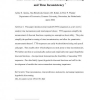ICDE
2009
IEEE
13 years 9 months ago
2009
IEEE
There is a huge wealth of sequence data available, for example, customer purchase histories, program execution traces, DNA, and protein sequences. Analyzing this wealth of data to ...
SIGDIAL
2010
13 years 9 months ago
2010
This paper proposes a novel approach for predicting user satisfaction transitions during a dialogue only from the ratings given to entire dialogues, with the aim of reducing the c...
ICPR
2010
IEEE
13 years 9 months ago
2010
IEEE
In this paper, we propose a novel approach to capture the dynamic deformation caused by facial expressions. The proposed method is concentrated on the spatiotemporal plane which i...
BIBM
2010
IEEE
13 years 10 months ago
2010
IEEE
We propose a method for finding CRMs in a set of co-regulated genes. Each CRM consists of a set of binding sites of transcription factors. We wish to find CRMs involving the same t...
ACL
2010
13 years 10 months ago
2010
Classical Information Extraction (IE) systems fill slots in domain-specific frames. This paper reports on SEQ, a novel open IE system that leverages a domainindependent frame to e...
WABI
2010
Springer
13 years 10 months ago
2010
Springer
Quantification of selective pressures on regulatory sequences is a central question in studying the evolution of gene regulatory networks. Previous methods focus primarily on sing...
TCOM
2010
13 years 10 months ago
2010
—Training sequences for data-aided timing estimation in multi-input multi-output systems are designed. It is observed that for low complexity implementation, the sequences must n...
RAID
2010
Springer
13 years 10 months ago
2010
Springer
Abstract. Run-time malware detection strategies are efficient and robust, which get more and more attention. In this paper, we use I/O Request Package (IRP) sequences for malware d...
MANSCI
2010
13 years 10 months ago
2010
This paper introduces time-tradeoff (TTO) sequences as a new tool to analyze time inconsistency and intertemporal choice. TTO sequences simplify the measurement of discount functio...
INFORMATICALT
2010
13 years 10 months ago
2010
The genetic information in cells is stored in DNA sequences, represented by a string of four letters, each corresponding to a definite type of nucleotides. Genomic DNA sequences a...


